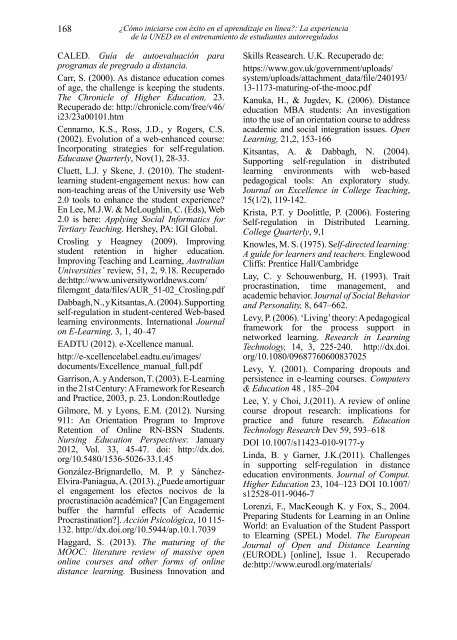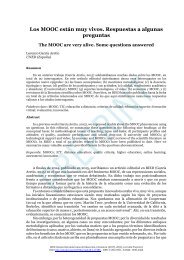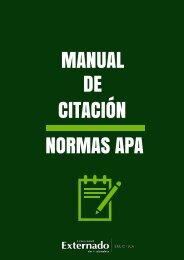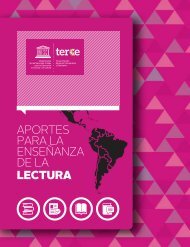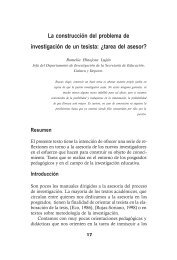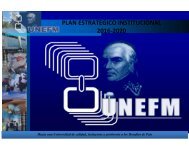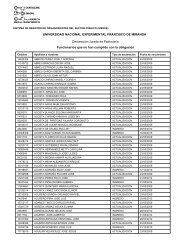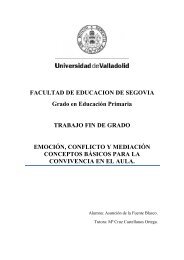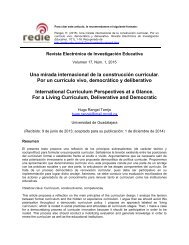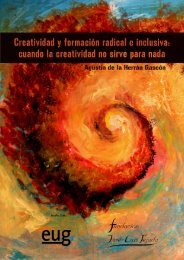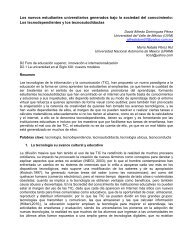Recursos-del-Aprendizaje
Recursos-del-Aprendizaje
Recursos-del-Aprendizaje
You also want an ePaper? Increase the reach of your titles
YUMPU automatically turns print PDFs into web optimized ePapers that Google loves.
168 ¿Cómo iniciarse con éxito en el aprendizaje en línea: La experiencia<br />
de la UNED en el entrenamiento de estudiantes autorregulados<br />
CALED. Guía de autoevaluación para<br />
programas de pregrado a distancia.<br />
Carr, S. (2000). As distance education comes<br />
of age, the challenge is keeping the students.<br />
The Chronicle of Higher Education, 23.<br />
Recuperado de: http://chronicle.com/free/v46/<br />
i23/23a00101.htm<br />
Cennamo, K.S., Ross, J.D., y Rogers, C.S.<br />
(2002). Evolution of a web-enhanced course:<br />
Incorporating strategies for self-regulation.<br />
Educause Quarterly, Nov(1), 28-33.<br />
Cluett, L.J. y Skene, J. (2010). The studentlearning<br />
student-engagement nexus: how can<br />
non-teaching areas of the University use Web<br />
2.0 tools to enhance the student experience<br />
En Lee, M.J.W. & McLoughlin, C. (Eds), Web<br />
2.0 is here: Applying Social Informatics for<br />
Tertiary Teaching. Hershey, PA: IGI Global.<br />
Crosling y Heagney (2009). Improving<br />
student retention in higher education.<br />
Improving Teaching and Learning, Australian<br />
Universities’ review, 51, 2, 9.18. Recuperado<br />
de:http://www.universityworldnews.com/<br />
filemgmt_data/files/AUR_51-02_Crosling.pdf<br />
Dabbagh, N., y Kitsantas, A. (2004). Supporting<br />
self-regulation in student-centered Web-based<br />
learning environments. International Journal<br />
on E-Learning, 3, 1, 40–47<br />
EADTU (2012). e-Xcellence manual.<br />
http://e-xcellencelabel.eadtu.eu/images/<br />
documents/Excellence_manual_full.pdf<br />
Garrison, A. y Anderson, T. (2003). E-Learning<br />
in the 21st Century: A Framework for Research<br />
and Practice, 2003, p. 23. London:Routledge<br />
Gilmore, M. y Lyons, E.M. (2012). Nursing<br />
911: An Orientation Program to Improve<br />
Retention of Online RN-BSN Students.<br />
Nursing Education Perspectives: January<br />
2012, Vol. 33, 45-47. doi: http://dx.doi.<br />
org/10.5480/1536-5026-33.1.45<br />
González-Brignar<strong>del</strong>lo, M. P. y Sánchez-<br />
Elvira-Paniagua, A. (2013). ¿Puede amortiguar<br />
el engagement los efectos nocivos de la<br />
procrastinación académica [Can Engagement<br />
buffer the harmful effects of Academic<br />
Procrastination]. Acción Psicológica, 10 115-<br />
132. http://dx.doi.org/10.5944/ap.10.1.7039<br />
Haggard, S. (2013). The maturing of the<br />
MOOC: literature review of massive open<br />
online courses and other forms of online<br />
distance learning. Business Innovation and<br />
Skills Reasearch. U.K. Recuperado de:<br />
https://www.gov.uk/government/uploads/<br />
system/uploads/attachment_data/file/240193/<br />
13-1173-maturing-of-the-mooc.pdf<br />
Kanuka, H., & Jugdev, K. (2006). Distance<br />
education MBA students: An investigation<br />
into the use of an orientation course to address<br />
academic and social integration issues. Open<br />
Learning, 21,2, 153-166<br />
Kitsantas, A. & Dabbagh, N. (2004).<br />
Supporting self-regulation in distributed<br />
learning environments with web-based<br />
pedagogical tools: An exploratory study.<br />
Journal on Excellence in College Teaching,<br />
15(1/2), 119-142.<br />
Krista, P.T. y Doolittle, P. (2006). Fostering<br />
Self-regulation in Distributed Learning.<br />
College Quarterly, 9,1<br />
Knowles, M. S. (1975). Self-directed learning:<br />
A guide for learners and teachers. Englewood<br />
Cliffs: Prentice Hall/Cambridge<br />
Lay, C. y Schouwenburg, H. (1993). Trait<br />
procrastination, time management, and<br />
academic behavior. Journal of Social Behavior<br />
and Personality, 8, 647–662.<br />
Levy, P. (2006). ‘Living’ theory: A pedagogical<br />
framework for the process support in<br />
networked learning. Research in Learning<br />
Technology, 14, 3, 225-240. http://dx.doi.<br />
org/10.1080/09687760600837025<br />
Levy, Y. (2001). Comparing dropouts and<br />
persistence in e-learning courses. Computers<br />
& Education 48 , 185–204<br />
Lee, Y. y Choi, J.(2011). A review of online<br />
course dropout research: implications for<br />
practice and future research. Education<br />
Technology Research Dev 59, 593–618<br />
DOI 10.1007/s11423-010-9177-y<br />
Linda, B. y Garner, J.K.(2011). Challenges<br />
in supporting self-regulation in distance<br />
education environments. Journal of Comput.<br />
Higher Education 23, 104–123 DOI 10.1007/<br />
s12528-011-9046-7<br />
Lorenzi, F., MacKeough K. y Fox, S., 2004.<br />
Preparing Students for Learning in an Online<br />
World: an Evaluation of the Student Passport<br />
to Elearning (SPEL) Mo<strong>del</strong>. The European<br />
Journal of Open and Distance Learning<br />
(EURODL) [online], Issue 1. Recuperado<br />
de:http://www.eurodl.org/materials/


